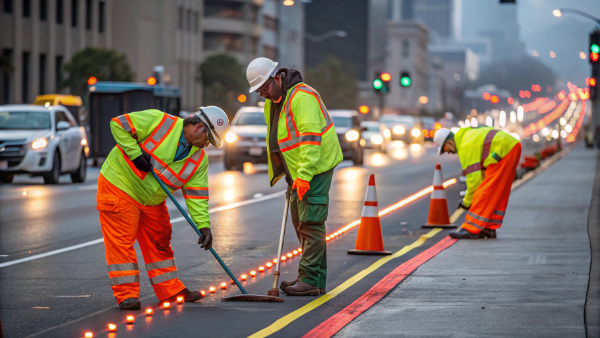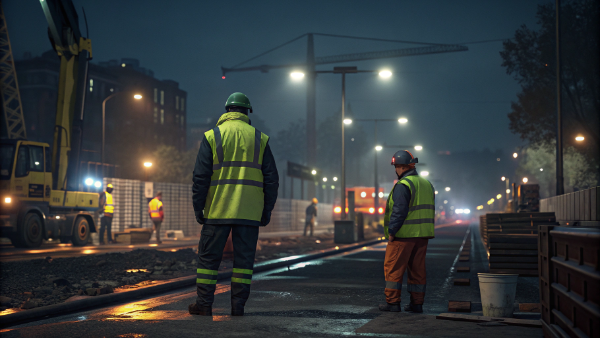Struggling to trust your safety gear? Low-quality reflective materials can fail, putting workers at risk and costing you money. I will explain the science behind effective, life-saving reflective apparel.
The reflective part of high-visibility clothing is made from tiny glass beads or microscopic prisms. These elements are engineered to bounce light directly back to its source, like a car's headlights, making the wearer visible. They are often backed with a metallic coating to enhance brightness.
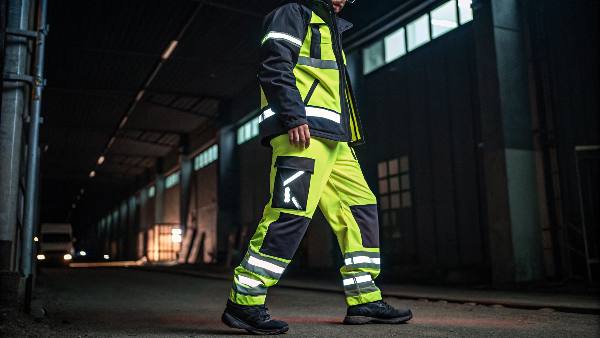
I’ve been in the personal protective equipment (PPE) business for over 25 years. I learned early on that not all high-visibility clothing is created equal. The real difference between a reliable garment and a dangerous one often comes down to the quality and construction of the reflective tape. A failure here is not just a product defect; it’s a safety failure. I've built my business on sourcing products I can trust, and that trust starts with understanding the materials. Let’s dive into what makes these garments work, so you can make informed decisions that protect your team and your company.
What is reflective clothing1 made of?
Are you confused by the different materials in a safety vest? The fabric and the reflective tape serve separate, vital functions. Choosing the right combination is critical for worker safety.
Reflective clothing consists of two main parts: a fluorescent base fabric2 for daytime visibility and retro-reflective tapes for nighttime. The base is typically a durable polyester, while the tapes contain glass beads or prisms.
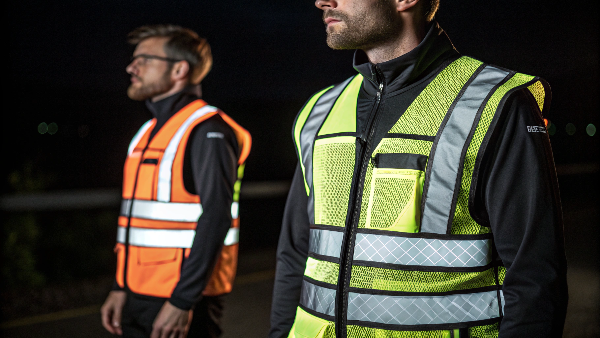
To really understand reflective clothing, you have to look at it as a system with two key components working together. First is the base fabric, and second is the reflective material3 itself. One provides visibility during the day, and the other handles the night.
-
Base Fabric: This is the main body of the garment. Its primary job is to make the wearer stand out in daylight, especially at dawn and dusk. This is achieved with fluorescent colors—bright yellows, oranges, or reds—that appear incredibly bright under sunlight. The material itself is usually polyester because it holds these vibrant colors well and is very durable. For workers in hotter climates, we often look for polyester-cotton blends to improve breathability.
-
Reflective Material: This is the silver or gray tape you see on the garments. Its only job is to reflect light back at its source in low-light or nighttime conditions.
Here is a simple breakdown of common base fabrics I consider when sourcing for my clients.
| Fabric Type | Primary Use | Pros | Cons |
|---|---|---|---|
| 100% Polyester | General Workwear | Durable, holds fluorescent color well, resists wrinkles | Less breathable than cotton |
| Polyester/Cotton Blend | Warmer climates, comfort | More breathable, comfortable on skin | Can fade faster than pure polyester |
| Modacrylic Blends | Fire-risk environments | Flame-resistant (FR) properties | More expensive, can be heavier |
What is the reflective layer made of?
Have you ever wondered about the science inside that reflective tape? It’s not just shiny plastic. The technology within that layer is what separates high-quality gear from cheap imitations.
The reflective layer4 is a complex structure. It contains microscopic glass beads5 or microprisms bonded to a base film. Behind these elements, a metallic coating of aluminum or silver acts as a mirror to maximize light return.
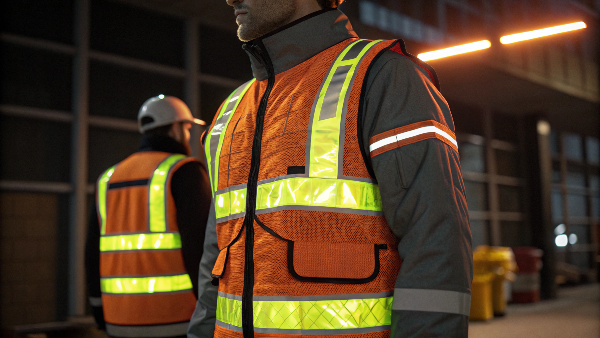
The "magic" of reflective tape happens in its layered construction. It’s a very precise and technical product. When I work with my supplier, Vissafety, we pay close attention to the quality of each layer, because a failure in one compromises the entire system. Their in-house labs test these materials to ensure they meet strict standards like ANSI/ISEA 107.
Here’s how the layers are typically built, from the outside in:
- Top Layer: A clear, protective film that shields the inner layers from abrasion, dirt, and moisture.
- Optical Layer: This is the most important part. It holds either thousands of tiny glass beads or precision-engineered microprisms. This layer captures incoming light.
- Reflective Coating: Directly behind the optical layer is an ultra-thin coating of metal, usually aluminum. This acts like the mirror in a flashlight, bouncing the captured light straight back out.
- Bonding and Backing Layer: This final layer is what attaches the tape to the garment. It can be an adhesive for heat-transfer applications or a fabric backing for sew-on tapes.
The quality of each layer determines the tape's brightness and durability.
What material are reflectors made of?
Are you trying to choose between different types of reflective tape6? The material directly impacts performance, durability, and cost. Making the wrong choice can compromise worker safety and your budget.
Reflectors on safety apparel are primarily made from two materials: glass beads or microprismatic vinyl. Glass beads are flexible and common, while microprisms offer superior brightness and performance, especially in wet conditions.
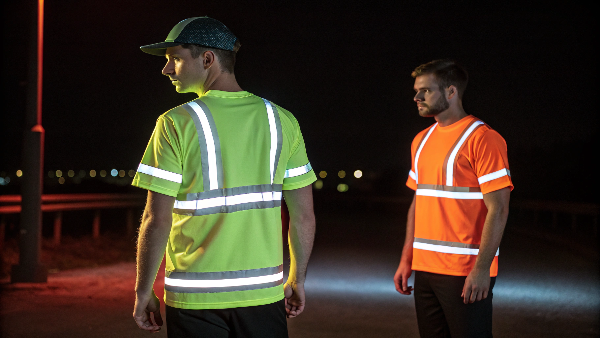
When I source reflective apparel, one of the first questions I discuss with Vissafety is whether to use glass bead or microprismatic tape. The choice depends entirely on the end-user's work environment and the level of risk involved. Both materials use the principle of retro-reflection, but they achieve it in different ways.
Glass Bead Material7: This is the classic and most common type of reflective material. It works by embedding tiny, spherical glass beads into a resin. When light enters a bead, it's focused onto a reflective coating on the back, then bounced back toward the light source. It's flexible and cost-effective, making it great for general use. However, its performance can decrease when it gets wet, as the water on the surface can disrupt the light path.
Microprismatic Material8: This is a more advanced technology. Instead of beads, it uses tiny, precisely shaped prisms, similar to what you’d find on a traffic sign. Light enters and bounces off the internal surfaces of the prism before being sent back. This method is much more efficient and provides a brighter reflection. It also performs exceptionally well in the rain. Because of its rigid structure and higher cost, it's typically used for high-performance gear where visibility is absolutely critical.
| Reflector Material | How It Works | Best For | Reflectivity Level | Durability |
|---|---|---|---|---|
| Glass Bead | Tiny spheres focus light onto a reflective back-coating. | General use, budget-conscious projects | Good | Moderate |
| Microprismatic | Cube-corner prisms reflect light internally. | High-risk areas, all-weather use | Excellent | High |
What material is used for reflective?
Are you overwhelmed by technical terms like polyurethane and vinyl? These materials are the foundation of reflective tape. Let’s simplify what they do and why they are important for safety.
The core reflective elements (glass beads or prisms) are held in a carrier film. This film is usually made of a durable polymer like polyurethane (PU) or polyvinyl chloride (PVC) for protection and flexibility.
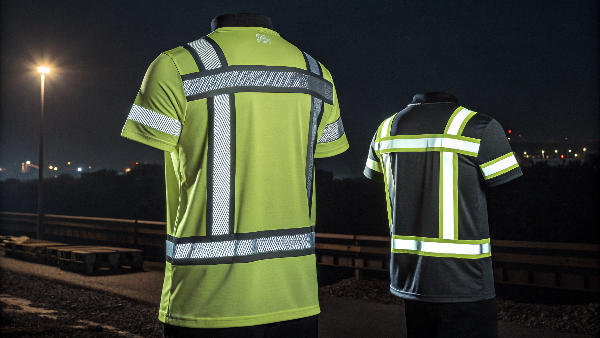
The carrier material that holds the glass beads or prisms is just as important as the reflective elements themselves. It determines the tape’s flexibility, durability, and how it can be applied to a garment. Choosing the right one is key to making a product that lasts.
For a project back in 2020, my clients needed lightweight, breathable safety jackets for workers in high-temperature environments. The jackets used a stretchy fabric, so we needed a reflective tape that could move with it. I worked with Vissafety to select a tape with a polyurethane (PU) base. It was applied with heat and bonded perfectly, stretching with the fabric without cracking.
Here are the common carrier materials:
- Polyurethane (PU): This is a very flexible polymer. It’s the go-to material for heat-transfer reflective tapes that are applied to stretchable fabrics like knit polyesters. It feels soft and moves with the wearer.
- Polyvinyl Chloride (PVC): PVC is much more rigid and extremely durable. It’s often used for sew-on tapes or on hard surfaces like traffic cones and barrels because it can withstand a lot of abrasion.
- Fabric Backing: For traditional sew-on applications, the reflective layer is bonded to a sturdy fabric base, often a polyester-cotton blend. This provides the strength needed to withstand industrial laundering.
What is the reflective coating made of?
Do you think the shine on reflective tape is just silver paint? The coating behind the reflective elements is a critical, high-tech layer. A cheap coating fails fast, making a garment useless.
The reflective coating is a micro-thin layer of metal, typically vaporized aluminum, applied to the back of the glass beads or prisms. This metallic layer functions as a high-efficiency mirror.

This metallic coating is the unsung hero of retro-reflection. Without it, the light captured by the beads or prisms would just pass through. This layer is responsible for bouncing it back. The quality of this coating is something I am extremely careful about. Years ago, in 2015, a $500,000 loss from a different supplier was traced back to a faulty batch with color inconsistencies, likely caused by a poor coating process.
This is why I value the triple QC process at Vissafety. They ensure this critical layer is applied perfectly every time. The process itself is quite advanced. It’s usually done through a method called vapor deposition, where aluminum is heated in a vacuum until it becomes a gas. This vapor then settles onto the back of the bead or prism layer, creating a flawless, highly reflective mirror that is just atoms thick.
Aluminum is the standard choice because it is highly reflective, chemically stable, and cost-effective. For some specialty applications, silver might be used for even higher reflectivity, but it's more expensive and can tarnish if not protected properly.
What makes reflective clothing glow?
Does reflective clothing use batteries or glow in the dark? This common confusion can lead to unsafe choices. Understanding the real science is key to appreciating its life-saving function.
Reflective clothing does not glow on its own. It appears to glow when a light source, like headlights, shines on it. The material returns that light directly back to the source's origin.
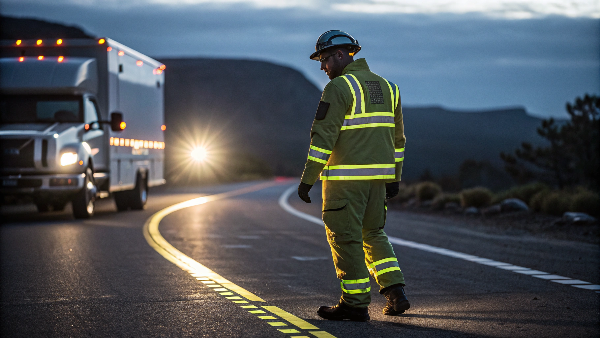
One of the first things I teach new buyers is the difference between the three main types of visibility: fluorescent, retro-reflective, and phosphorescent. People often use the term "glow" for all of them, but they work in completely different ways. Confusing them can be dangerous. For instance, a "glow-in-the-dark" material is useless for a roadside worker at night.
High-visibility clothing combines two of these types for 24-hour protection:
- Fluorescent Material (Daytime): This is the bright yellow or orange fabric. It takes invisible UV light from the sun and converts it into visible light, making the garment appear exceptionally bright during the day. It needs a UV source (daylight) to work.
- Retro-Reflective Material (Nighttime): This is the tape. It does not create its own light. It works like a mirror, but only for the person or object that is the source of the light. It needs an external light source, like headlights, to function.
Here’s a table to make it clear.
| Visibility Type | How It Works | Best Use Case | Power Source Needed |
|---|---|---|---|
| Fluorescent | Converts invisible UV light to visible light. | Daytime, Dawn, Dusk | Sunlight (UV rays) |
| Retro-reflective | Reflects light directly back to its source. | Nighttime, Low-Light | External light (e.g., headlights) |
| Phosphorescent | Absorbs and slowly releases light energy. | Novelty, Marked Escape Routes | Pre-charging with light |
Conclusion
Understanding the materials in reflective clothing—from fluorescent fabrics to tapes with glass beads or prisms—is essential for ensuring worker safety and making smart, reliable purchasing decisions for your business.
-
Understanding the materials in reflective clothing is essential for ensuring safety and compliance in various work environments. ↩
-
Choosing the right base fabric can significantly impact comfort and visibility, making it crucial for worker safety. ↩
-
Exploring different reflective materials helps in selecting the most effective gear for low-light conditions, enhancing safety. ↩
-
Understanding the composition of the reflective layer can enhance your knowledge of safety gear technology and its effectiveness. ↩
-
Exploring the role of microscopic glass beads can reveal how they enhance visibility and safety in various applications. ↩
-
Discover the best types of reflective tape for safety apparel to ensure optimal performance and safety in different work environments. ↩
-
Explore the benefits of Glass Bead Material for reflective apparel, especially its cost-effectiveness and flexibility for general use. ↩
-
Learn how Microprismatic Material improves visibility and performance in various conditions, making it ideal for high-risk environments. ↩

